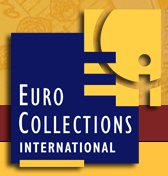April 17, 2013 - The Austrian Mint has started an exciting new five-coin series on Prehistoric Life, featuring the dinosaurs and early life in the water, on land, and in the air of middle western Europe from the Triassic to the Quaternary period.

Austria 2013 20€ Prehistoric Life - Triassic Silver Proof
This first coin in the series features the Triassic period. The main focal point of the obverse is a live interpretation of an extinct type of a cephalopod, looking somewhat like a nautilus shell, with its front tentacle-like appendages extending beneath the face value of 20 euros. The cephalopod is also featured in a fossilized form (located in the History museum in Vienna) just a bit lower and to the left of the live interpretation. The line going across the lower third of the coin’s design field is a time line that highlights the Triassic (Trias) period of 250 to 200 million years ago. This line will continue on through each of the next four prehistoric periods and coins featured in this series.
The obverse also includes the country of issue, “Republik Oesterreich, the year of issue 2012 and the face value of 20 euros. This side of the coin was designed by Mint engraver Helmut Andexlinger.
The reverse side of the coin was designed and engraved by fellow mint engraver Herbert Waehner. An ichthyosaurus (looking somewhat like a modern-day dolphin) is depicted in the upper half of this side. In its long and narrow jaws is an ammonite. Below the ichthyosaurus swims a nothosauras. Both animals lived in the seas during the middle and upper Triassic period in what would today be the Mediterranean Sea. The depth perception of the coin is cleverly enhanced by the engraver who integrated a great variety of flora that seem to be moving in the water around these two creatures.
Life around 250 million years ago already consisted of land plants and reptiles. The former evolved in the Silurian period over 400 million years ago. The latter evolved towards the end of the carboniferous period about 290 million years ago, from the amphibians, which migrated from water to land at the end of the Devonian period about 360 million years ago. The carboniferous period is of course the key period from which all the rich coal deposits where produced from which we still benefit today.
By the end of the Permian period, 250 million years ago, reptiles had taken over on land. Ninety percent of the flora and fauna on earth disappeared probably because of some catastrophic event causing climate change. The lack of plants meant that the temperature swings were great and reptiles with their hard outer shells could withstand these extremes.
The Triassic period of 250 to 200 million years ago was the period of great change when the dinosaurs first appeared. The super continent of Pangea had formed during this time and by the end of the Triassic period it broke apart into two, Laurasia in the north and Gondwana land in the south.
The Triassic period was rich with sea life and numerous types of shell-like animals such as the ammonite inhabited the waters. Giant reptiles such as the ichthyosaurus and nothosauras appeared in the water. The waters were filled with phytoplankton, the first or lowest part of the food chain, which also still exists today. Corals began to grow during the Triassic period. On land basic insects such as spiders, millipeds, centipodes and grasshoppers developed. Ferns, moss, palms and coniferous trees grew on land. Towards the end of the Triassic period the first dinosaurs and furry animals appeared, such as the kangaroo-like prosauropods and shrew-like megazostrodons. The Triassic period ended with another catastrophic event perhaps a meteor, asteroid collision, or volcanic eruption and much of life was destroyed.
The new coin is available in proof finish-only, contains 18 grams of silver, and is 900 fine, weighs 20 grams, with a diameter is 34 mm. The coin is encapsulated and comes with a certificate of authenticity and packed a protective case, with a sleeve. The maximum mintage for each coin of this series is 50,000.
Exciting new packaging will accompany this coin. An elegant black collector case, in which all the individual coin certificates can also be housed, may be purchased separately. In addition it will be accompanied by a folder with thorough scientific background on the series.
As well an exciting new app developed together with the Natural History Museum of Vienna, will be available as of April. Simply download it for free to your smart phone or tablet. For more information Click Here |

|



